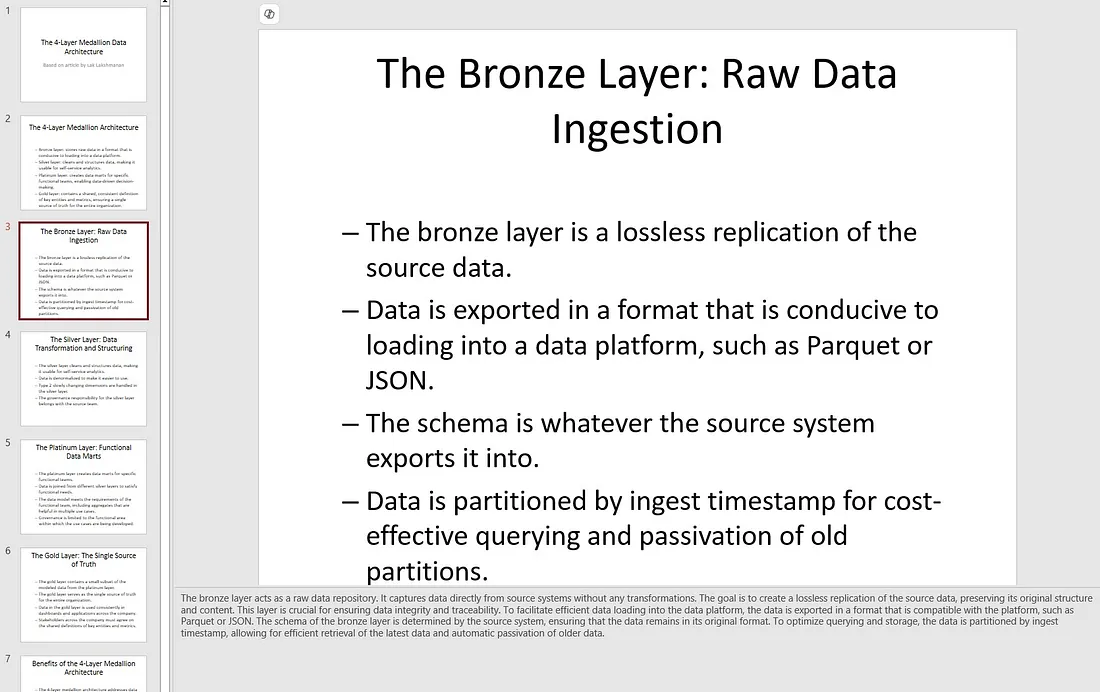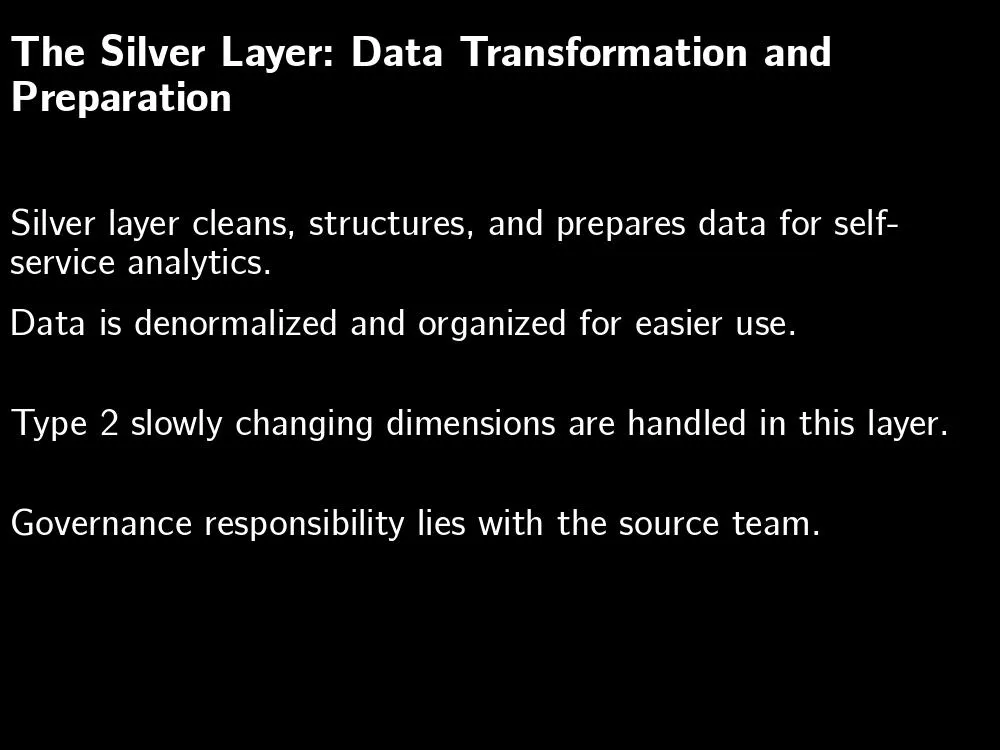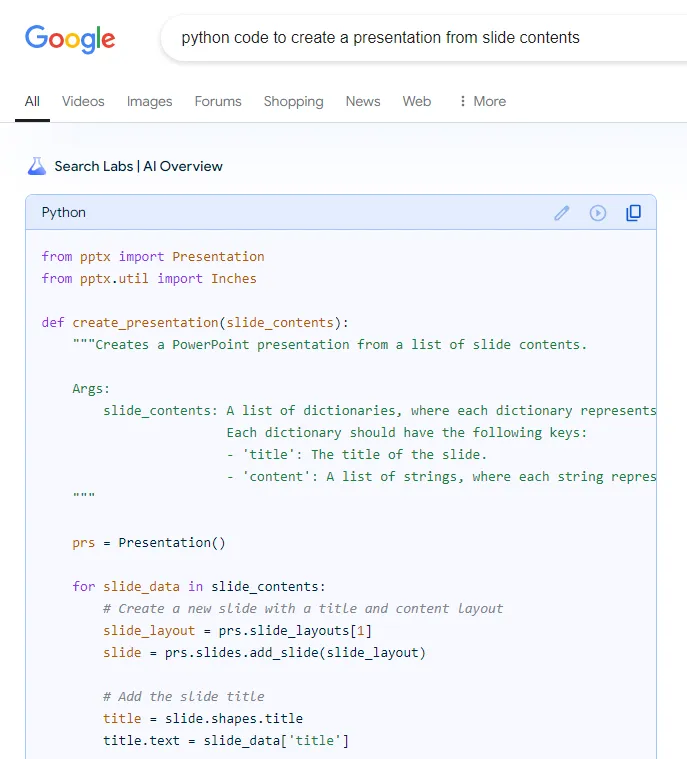利用生成式AI:自动创建文章视频演讲
目标:从文章中创建视频谈话
有些人喜欢翻阅幻灯片,有些人喜欢观看视频,这将是满足他们需求的好方法。在本文中,我将向你展示如何做到这一点。
1. 初始化 LLM
我将使用 Google Gemini Flash,因为 (a) 它是目前最便宜的前沿 LLM,(b) 它是多模式的,因为它也可以读取和理解图像,(c) 它支持受控生成,这意味着我们可以确保 LLM 的输出符合所需的结构。
import pdfkit
import os
import google.generativeai as genai
from dotenv import load_dotenv
load_dotenv("../genai_agents/keys.env")
genai.configure(api_key=os.environ["GOOGLE_API_KEY"])
请注意,我使用的是 Google Generative AI,而不是 Google Cloud Vertex AI。这两个软件包不同。Google 的包支持 Pydantic 对象的可控生成;而 Vertex AI 的包目前只支持 JSON。
2. 获取文章的 PDF 文件
我使用 Python 将文章下载为 PDF 格式,并上传到 Gemini 可以读取的临时存储位置:
ARTICLE_URL = "https://lakshmanok.medium...."
pdfkit.from_url(ARTICLE_URL, "article.pdf")
pdf_file = genai.upload_file("article.pdf")
不幸的是,由于介质的原因,pdfkit 无法获取文章中的图片。因此,我的幻灯片将只基于文章的文字而不是图片。
3. 用 JSON 创建讲座笔记
在这里,我需要的数据格式是一组幻灯片,每张幻灯片都有标题、要点和讲义。整个讲座也有一个标题和一个归属。
class Slide(BaseModel):
title: str
key_points: List[str]
lecture_notes: str
class Lecture(BaseModel):
slides: List[Slide]
lecture_title: str
based_on_article_by: str
让我们告诉Gemini我们想要它做什么:
lecture_prompt = """
You are a university professor who needs to create a lecture to
a class of undergraduate students.
* Create a 10-slide lecture based on the following article.
* Each slide should contain the following information:
- title: a single sentence that summarizes the main point
- key_points: a list of between 2 and 5 bullet points. Use phrases, not full sentences.
- lecture_notes: 3-10 sentences explaining the key points in easy-to-understand language. Expand on the points using other information from the article.
* Also, create a title for the lecture and attribute the original article's author.
"""
提示非常直接--要求Gemini阅读文章、提取要点并创建讲义。
现在,调用模型,传入 PDF 文件并要求它填充所需的结构:
model = genai.GenerativeModel(
"gemini-1.5-flash-001",
system_instruction=[lecture_prompt]
)
generation_config={
"temperature": 0.7,
"response_mime_type": "application/json",
"response_schema": Lecture
}
response = model.generate_content(
[pdf_file],
generation_config=generation_config,
stream=False
)
关于上面的代码,有几点需要注意:
- 我们将提示作为系统提示传入,这样就不需要在输入新内容时不断发送提示。
- 我们将所需的响应类型指定为 JSON,并将模式指定为 Pydantic 对象。
- 我们将 PDF 文件发送给模型,并告诉它生成一个响应。我们将等待它完成(无需流式处理)
结果是 JSON,因此将其提取为 Python 对象:
lecture = json.loads(response.text)
例如,第 3 张幻灯片如下所示:
{'key_points': [
'Silver layer cleans, structures, and prepares data for self-service analytics.',
'Data is denormalized and organized for easier use.',
'Type 2 slowly changing dimensions are handled in this layer.',
'Governance responsibility lies with the source team.'
],
'lecture_notes': 'The silver layer takes data from the bronze layer and transforms it into a usable format for self-service analytics. This involves cleaning, structuring, and organizing the data. Type 2 slowly changing dimensions, which track changes over time, are also handled in this layer. The governance of the silver layer rests with the source team, which is typically the data engineering team responsible for the source system.',
'title': 'The Silver Layer: Data Transformation and Preparation'
}4. 转换为 PowerPoint
我们可以使用 Python 软件包 pptx 创建带有注释和要点的演示文稿。创建幻灯片的代码如下:
for slidejson in lecture['slides']:
slide = presentation.slides.add_slide(presentation.slide_layouts[1])
title = slide.shapes.title
title.text = slidejson['title']
# bullets
textframe = slide.placeholders[1].text_frame
for key_point in slidejson['key_points']:
p = textframe.add_paragraph()
p.text = key_point
p.level = 1
# notes
notes_frame = slide.notes_slide.notes_text_frame
notes_frame.text = slidejson['lecture_notes']
结果就是这样的 PowerPoint 演示文稿:

虽然不是很花哨,但如果你要发表演讲,这绝对是一个很好的编辑起点。
5. 朗读笔记并保存音频
我们已经有了讲座笔记,现在就来创建每张幻灯片的音频文件。
下面的代码可以获取一些文本,并让人工智能语音朗读出来。我们将生成的音频保存为 mp3 文件:
from google.cloud import texttospeech
def convert_text_audio(text, audio_mp3file):
"""Synthesizes speech from the input string of text."""
tts_client = texttospeech.TextToSpeechClient()
input_text = texttospeech.SynthesisInput(text=text)
voice = texttospeech.VoiceSelectionParams(
language_code="en-US",
name="en-US-Standard-C",
ssml_gender=texttospeech.SsmlVoiceGender.FEMALE,
)
audio_config = texttospeech.AudioConfig(
audio_encoding=texttospeech.AudioEncoding.MP3
)
response = tts_client.synthesize_speech(
request={"input": input_text, "voice": voice, "audio_config": audio_config}
)
# The response's audio_content is binary.
with open(audio_mp3file, "wb") as out:
out.write(response.audio_content)
print(f"{audio_mp3file} written.")
上面的代码中发生了什么?
- 我们正在使用谷歌云的文本到语音 API
- 要求它使用标准的美国口音女声。如果你要制作播客,你可以在这里输入 “说话者地图”,每个说话者使用一个声音。
- 然后,我们将输入文本交给它,要求它生成音频
- 将音频保存为 mp3 文件。请注意,这必须与音频编码相匹配。
现在,通过迭代幻灯片和传入讲座笔记来创建音频:
for slideno, slide in enumerate(lecture['slides']):
text = f"On to {slide['title']} \n"
text += slide['lecture_notes'] + "\n\n"
filename = os.path.join(outdir, f"audio_{slideno+1:02}.mp3")
convert_text_audio(text, filename)
filenames.append(filename)
结果就是一堆音频文件。你可以使用 pydub 将它们串联起来:
combined = pydub.AudioSegment.empty()
for audio_file in audio_files:
audio = pydub.AudioSegment.from_file(audio_file)
combined += audio
# pause for 4 seconds
silence = pydub.AudioSegment.silent(duration=4000)
combined += silence
combined.export("lecture.wav", format="wav")
但事实证明,我并不需要这样做。我需要为每张幻灯片制作一个单独的音频文件来制作视频。
6. 创建幻灯片图像
比较恼人的是,没有一种简单的方法能用 Python 将 PowerPoint 幻灯片渲染成图像。你需要一台安装了 Office 软件的机器才能做到这一点--这可不是一件容易实现自动化的事情。也许我应该使用 Google 幻灯片......总之,渲染图像的简单方法是使用 Python 图像库 (PIL):
def text_to_image(output_path, title, keypoints):
image = Image.new("RGB", (1000, 750), "black")
draw = ImageDraw.Draw(image)
title_font = ImageFont.truetype("Coval-Black.ttf", size=42)
draw.multiline_text((10, 25), wrap(title, 50), font=title_font)
text_font = ImageFont.truetype("Coval-Light.ttf", size=36)
for ptno, keypoint in enumerate(keypoints):
draw.multiline_text((10, (ptno+2)*100), wrap(keypoint, 60), font=text_font)
image.save(output_path)
生成的图像不是很好,但还可以使用(你可以看出已经没有人付钱让我写生产代码了):

7. 创建视频
现在我们有了一组音频文件和一组图像文件,可以使用 Python 包 moviepy 来创建视频片段:
clips = []
for slide, audio in zip(slide_files, audio_files):
audio_clip = AudioFileClip(f"article_audio/{audio}")
slide_clip = ImageClip(f"article_slides/{slide}").set_duration(audio_clip.duration)
slide_clip = slide_clip.set_audio(audio_clip)
clips.append(slide_clip)
full_video = concatenate_videoclips(clips)
现在我们可以把它写出来了:
full_video.write_videofile("lecture.mp4", fps=24, codec="mpeg4",
temp_audiofile='temp-audio.mp4', remove_temp=True)最终结果如何?我们有四个人工制品,都是根据文章.pdf 自动创建的:
lecture.json lecture.mp4 lecture.pptx lecture.wav
8. 这对软件的未来有何启示
我们都在探索这项很酷的技术(生成式人工智能)可以用来做什么。你可以用它来创建内容,但它创建的内容适合头脑风暴,却不能原封不动地使用。经过三年的技术改进,GenAI 生成的内容都是废话,代码也不能直接使用。
这让我们想到了 GenAI 提供的一些辅助功能。这些辅助功能都非常有用。这篇文章介绍了 GenAI 的四种功能。
(1) 将非结构化数据转化为结构化数据
Attention 论文是为了解决翻译问题而撰写的,事实证明基于 Transformer 的模型在翻译方面确实很出色。我们不断发现这方面的用例。但不仅仅是日语到英语,还有Java 11 到 Java 17、文本到 SQL、文本到语音、数据库方言之间……,现在还有文章到音频脚本。事实证明,这是使用 GenAI 创建播客、讲座、视频等的起点。
我所要做的就是提示 LLM 从文章中构建一系列幻灯片内容(关键点、标题等),它做到了。它甚至将数据以结构化的格式返回给我,有利于我在计算机程序中使用这些数据。具体来说,GenAI 在将非结构化数据转化为结构化数据方面确实很有一套。
(2) 代码搜索和编码辅助功能大幅提升
GenAI 真正擅长的另一件事是动态调整代码样本。我并不是每天都写代码来创建演示文稿、文本到语音或 moviepy。两年前,我会使用谷歌搜索,获取 Stack Overflow 页面,然后手工调整代码。现在,谷歌搜索为我提供了随时可用的代码:

当然,如果我使用的是 Python IDE(而不是 Jupyter 笔记本),就可以完全避免搜索步骤--我可以写一个注释,然后让代码为我生成。这非常有用,可以加快使用通用应用程序接口的开发速度。
(3) GenAI 网络服务强大且易于使用
别忘了,我使用了谷歌云文本到语音服务(Google Cloud Text-to-Speech service)将音频脚本转化为实际的音频文件。文本到语音本身就是一种生成式人工智能模型(也是翻译超级能力的另一个例子)。
在本文中,我使用了两个生成式人工智能模型--TTS 和 Gemini,它们都是作为网络服务提供的。我所要做的就是调用它们的 API。
(4) 提供终端用户自定义功能比以往任何时候都更容易
我并没有这样做,但你可以稍微观察一下,看看事情的发展方向。如果我将演示文稿创建、音频创建和电影创建代码封装在服务中,我就可以通过提示创建函数调用来调用这些服务。然后再添加一个请求处理代理,让你可以使用文本来改变幻灯片的外观和感觉,或者改变朗读视频的人的声音。
这样,为你构建的软件添加开放式自定义功能就变得非常容易了。
总结
我开始构建一个应用程序,将我的文章转换成视频讲座。关键步骤是促使 LLM 从文章中生成幻灯片内容,用另一个 GenAI 模型将音频脚本转换为音频文件,然后使用现有的 Python API 将它们组合成视频。
这篇文章说明了 GenAI 正在释放的四种能力:各种翻译、编码协助、强大的网络服务和终端用户定制能力。































